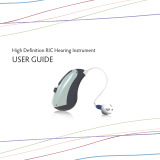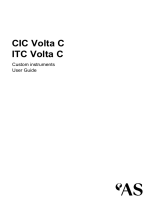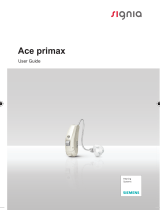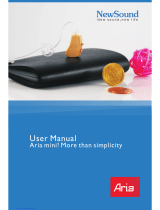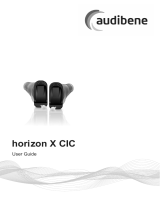Page is loading ...

USER GUIDE
CUSTOM MODELS:
CIC (COMPLETELY-IN-CANAL)
ITC (IN-THE-CANAL)
ITE (IN-THE-EAR)

2 3
Introduction
Congratulations on the purchase of your new hearing instru-
ments. ReSound’s innovative sound technology and design,
combined with the customized set-up selected by your hear-
ing care professional, will make hearing a more enjoyable ex-
perience. Hearing instruments will enable you to hear sounds
that you may not have heard in years because of your hearing
loss. Practice and a positive attitude are important in learning
to use hearing instruments. Your ReSound instruments have
been adjusted according to your individual hearing loss and
needs. Some people adjust quickly to wearing hearing instru-
ments in their ears and hearing new sounds; other people
may need more time.
Please read this manual carefully in order to wholly benefit
from the use of your hearing instruments. With proper care,
maintenance, and usage, your hearing instruments will aid
you in better communication for many years. Ask your hear-
ing care professional if you have any questions.
ReSound is a registred trade mark of GN ReSound A/S
Hearing instrument model:
Tube type: Dome size:
Left serial number:
Right serial number:
Model VE10 VE30 VE50
Battery size 10A 312 13
Intended Use
Generic air-conduction hearing instruments are wearable
sound-amplifying devices intended to compensate for im-
paired hearing. The fundamental operating principle of hear-
ing instruments is to receive, amplify, and transfer sound to
the ear drum of a hearing impaired person.
Notice:
1. A hearing aid will not restore normal hearing and will not
prevent or improve a hearing impairment resulting from or-
ganic conditions.
2. Consistent use of the aid is recommended. In most cases,
infrequent use does not permit you to attain full benefit from it.
3. The use of a hearing aid is only part of hearing rehabilitation
and may need to be supplemented by auditory training and
instructions in lip-reading.
Important Notice for Prospective Hearing Aid Users
Good health practice requires that a person with a hearing loss
have a medical evaluation by a licensed physician (preferably a
physician who specializes in diseases of the ear) before purchas-
ing a hearing aid. Licensed physicians who specialize in diseases
of the ear are often referred to as otolaryngologists, otologists or
otorhinolaryngologists. The purpose of the medical evaluation is
to assure that all medically treatable conditions that may affect
hearing are identified and treated before the hearing aid is pur-
chased.Following the medical evaluation, the physician will give
you a written statement that states that your hearing loss has
been medically evaluated and that you may be considered a can-
didate for a hearing aid. The physician will refer you to an audiolo-
gist or a hearing aid dispenser, as appropriate, for a hearing aid
evaluation.The audiologist or hearing aid dispenser will conduct
a hearing aid evaluation to assess your ability to hear with and
without a hearing aid. The hearing aid evaluation will enable the
audiologist or dispenser to select and fit a hearing aid to your in-
dividual needs.If you have reservations about your ability to adapt
to amplification, you should inquire about the availability of a trial-
rental or purchase-option program. Many hearing aid dispensers
now offer programs that permit you to wear a hearing aid for a
period of time for a nominal fee after which you may decide if you
want to purchase the hearing aid.Federal law restricts the sale of
hearing aids to those individuals who have obtained a medical
evaluation from a licensed physician. Federal law permits a fully
informed adult to sign a waiver statement declining the medical
evaluation for religious or personal beliefs that preclude consulta-
tion with a physician. The exercise of such a waiver is not in your
best health interest and its use is strongly discouraged.
Children with hearing loss
In addition to seeing a physician for a medical evaluation, a
child with a hearing loss should be directed to an audiologist
for evaluation and rehabilitation because hearing loss may
cause problems in language development and the educa-
tional and social growth of a child. An audiologist is qualified
by training and experience to assist in the evaluation and re-
habilitation of a child with hearing loss.

4 5
CONTENTS
Introduction .....................................2
Description of the hearing instruments .................6
Getting started ..................................10
On/Off function .................................10
SmartStart .....................................10
Inserting/Replacing the battery ......................11
Low battery indicator .............................11
Inserting/removing hearing instruments ................11
Operation of the hearing instrument ..................12
Volume control (optional)...........................12
Program button (optional) . . . . . . . . . . . . . . . . . . . . . . . . . . 13
Telephone use ..................................14
Telecoil (optional) ................................14
PhoneNow ....................................14
Tele-loop systems ...............................16
Care and maintenance ............................16
Daily maintenance ...............................17
Replacing wax filters..............................17
General precautions..............................18
General warnings................................19
Battery warning Information ........................21
Troubleshooting guide ............................22
Technical data ..................................24
Warranty and repairs .............................24
SYMBOLS
WARNING points out a situation that could lead to
serious injuries,
CAUTION indicates a situation that could lead to minor and
moderate injuries.
Advice and tips on how to handle your hearing instru-
ment better.

1
6
3
2
3/4
6
1
2
5
7
8
GN ReSound
Resound Vea
XXXXXXX
9
2
6 7
Description of the hearing instruments:
Completely-in-the-canal (CIC) Resound Vea™
VE210, VE210-P, VE310, VE310-P
1. Battery compartment and On/Off switch
2. Removal cord (optional)
3. Sound outlet
4. Wax filter
5. Venting
6. Microphone sound inlet(s)
7. Model
8. Manufacturer
9. Serial number

6
2
3/4
7
1
6
5
GN ReSound
ReSound Vea
XXXXXXX
10
9
8
5
8 9
In-the-canal (ITC) and In-the-ear (ITE)
ReSound Vea
TM
VE230, VE230-D, VE230-P, VE230-DP, VE330,
VE330-D, VE-330-P, VE330-DP
VE250, VE250-D, VE250-P, VE250-DP, VE350,
VE350-D, VE350-P, VE350-DP
1. Program button
2. Battery compartment and On/Off switch
3. Sound outlet
4. Wax filter
5. Venting
6. Microphone sound inlet(s)
7. Volume control (optional)
8. Model
9. Manufacturer
10. Serial number

10 11
SmartStart
Hearing instruments can be turned on once you have placed
them in your ears. If you prefer to turn them on just prior to
placing them in your ears, your hearing care professional can
activate a function called SmartStart. This function will delay
the time in which the hearing instruments turn on by ten sec-
onds after the battery compartment is closed. This reduces
the risk that the hearing instruments will whistle while you put
them in. With SmartStart, a beep will be heard for each sec-
ond of the delay period.
Getting started
On/Off function
1. When the battery door is closed, the hearing instrument
turns on, and the default program will be activ ated.
2. To turn off the hearing instrument, open the battery door.
Many individuals can use their fingernail to pull it open.
Tip: Whenever the hearing instruments are not in use,
remember to open the battery doors to avoid unnec-
essary battery consumption.
On
Off
Inserting/Replacing the battery
1. Open the battery door completely by using your fingernail.
2. Remove the used battery if present. Insert the new bat-
tery with the positive side in the correct position.
The bat-
tery door has a ‘+’ indicator to help determine the correct
insertion.
3. Always use new Zinc-Air batteries that have a minimum
remaining shelf-life of 1 year.
4. Gently close the battery door.
Tip: When the hearing instruments are not in use for an ex-
tended period of time, removing the batteries may help
prevent corrosion of the battery compartment, and en-
sure that battery life is not shortened.
Low battery indicator
Your hearing care professional can set your hearing instru-
ment to give an acoustical indication when the battery is
reaching its end of life. The hearing instrument will reduce
amplification and emit a melody if battery power gets too low.
This signal will recur every five minutes until the hearing instru-
ment automatically switches off. It is recommended that you
keep spare batteries on hand.
Inserting/Removing hearing instruments
Insertion (CIC, ITC, and ITE)
1. Hold the hearing instrument between
your thumb and index finger, either above
and below or on the sides.
2. Place the sound outlet portion into your
ear canal. Twist the hearing instrument
slightly back and forth until it sits well and
comfortably inside your ear. Opening and
closing your mouth may ease insertion

12 13
By experimenting, an easier method may be discovered.
With proper insertion, hearing instruments should fit snugly
but comfortably. If hearing instruments cause irritation of the
ears, contact your hearing care professional. Never attempt
to modify the shape of the hearing instrument yourself.
Tip: It may be helpful to pull your ear up and out-
ward with your opposite hand during insertion.
Removal (ITC and ITE)
1. Hold the edges of the hearing instrument
with your thumb and forefinger.
2. Pull outward while slightly rotating your
hand forward.
Removal (CIC)
1. Hold the removal cord with your thumb
and index finger and pull outward.
2. Hold the edges of the hearing instru-
ment with your thumb and forefinger
and pull outward while slightly rotating
your hand forward.
Note: Consult your hearing care profes-
sional if you have difficulty removing the hearing instruments.
Operation of the hearing instrument
Volume control (ITC and ITE models)
The volume control will allow the volume of hearing instru-
ments to be increased or decreased.
1. To increase the volume, rotate
the volume control forward
(towards your face when
you are wearing the hearing
instruments).
2. To decrease the volume,
rotate the volume control back-
ward (away from your face).
Please note that when you turn
the volume all the way down
(until the volume control wheel
stops rotating), the device will be turned off. To reboot the
device, turn the volume back up by rotating the volume
control forward.
If you prefer not to use the volume control, your hearing care
professional can deactivate it.
Program button
Depending on your experience level with hearing instruments,
individual hearing needs, and the type of listening environ-
ments you experience, your hearing care professional may
activate additional program in the hearing instrument. If addi-
tional program have been activated, the following list explains
how they work.
1. You can switch between program by pushing the pro-
gram button once.
2. You will then hear one or more beeps. The number of
beeps indicates which program you have selected (one
beep=program one, two beeps=program two, etc.).
3. When the hearing instruments are turned off and then
back on, the hearing instrument always returns to the
default setting (program one).
Program Description of when to use
1
2
3
4

14 15
Telephone use
Finding the optimal position for holding a tele phone may re-
quire practice for some individuals, and one or more of the
following suggestions may be helpful.
1. Hold the telephone as you would
normally.
2. Hold the telephone towards the
top of the ear (closer to where the
microphones are).
3. If whistling occurs, holding the
tele phone in the same position
may help the hearing instrument to
adapt.
4. Any whistling may also be de-
creased by holding the telephone
slightly away from the ear.
5. Depending on your individual
needs, your hearing care profes-
sional may activate a program
specifically for telephone use.
Telecoil (optional on some ITC and ITE models)
If equipped, a telecoil can be activated by your hearing care
professional and accessed through one of the additional pro-
grams. A telecoil picks up a telephone’s magnetic signal and
converts it to sound. An optional telephone program may help
to improve speech understanding on the telephone. When
using a telecoil program, the receiver of the telephone may
need to be held closer to the hearing instrument. The handset
of the telephone may need to be moved to slightly different
positions in order to find the best reception.
PhoneNow
The PhoneNow function, available on some hearing instru-
ment models, allows your hearing instrument to automatically
switch to you telephone program when a telephone receiver
is raised to the ear. When the telephone receiver is removed
from the ear, the hearing instrument automatically returns to
the previous listening program.
Placement of PhoneNow magnets
While some telephone receivers produce
a magnetic field strong enough to acti-
vate the Phone Now function, other tel-
ephone receivers require an additional
magnet to be placed on the tele phone
receiver. In order to place the PhoneNow
magnet properly:
1. Clean the telephone receiver thoroughly.
2. Hold the telephone vertically, in a position similar to when
making a telephone call.
3. Place the magnet just below the telephone receiver. If
necessary, move the magnet to another position to im-
prove ease of use and comfort while speaking.
Tip: Use only recommended cleaning agent to clean
the telephone prior to placing the magnet on the
phone in order to obtain best possible adherence.
PhoneNow usage
Telephones can be used in a normal manner. A beep sig-
nal will indicate that the PhoneNowfeature has automatically
switched the hearing instrument to your telephone program.
Initially, you may need to move the telephone receiver slightly
to find the best position for reliable PhoneNow activation and
good hearing on the telephone.
PhoneNow warnings
1. Keep magnets out of reach of pets, children and mentally
challenges persons. If a magnet is swallowed, please
seek advice from a medical practitioner.
2. The magnet used to supplement the magnetic field of a
telephone receiver may affect some medical devices or
electronic systems. The manufacturer of any magneti-
cally sensitive devices (e.g. pacemakers) should advise
you regarding appropriate safety precautions when using
your hearing instrument and magnet in close proximity
to the medical device or electronic system in question. If
the manufacturer cannot issue a statement, we recom-
mend keeping the magnet or a telephone equipped with
the magnet 30 cm (12”) away from magnetically sensitive
devices (e.g. pacemakers).

16 17
PhoneNow Precautions
1. High distortion during dialing or phoning may mean that
the magnet is not in the optimal position relative to the
telephone receiver. To avoid the issue, please move the
magnet to another place on the telephone receiver.
2. Only use magnets supplied by GN ReSound
Tele-loop systems
Many places, such as theatres, houses of worship, and
schools are equipped with tele-loop systems. When using a
telecoil program with tele-loop systems, sound is picked up
directly and may improve speech understanding. If there is no
sound from the hearing instruments in a tele-loop system and
with a telecoil program activated, the tele-loop system may
not be turned on or is not operating correctly. If a facility is not
equipped with a tele-loop system, sitting as close as possible
to the front may be helpful.
Care and maintenance
Your hearing instrument is protected by a layer of protective,
hydrophobic nanocoat material.
Please follow the following instructions to prolong the durabil-
ity of your hearing instruments:
1. Keep your hearing instrument clean and dry. Wipe the
case with a soft cloth or tissue after use to remove grease
or moisture. Do not use water or solvents, as these can
damage the hearing instrument(s).
2. Never immerse hearing instruments in water or other
liquids, as liquids may cause permanent damage to the
hearing instruments.
3. Avoid rough handling of hearing instruments or dropping
them on hard surfaces or floors.
4. Do not leave hearing instruments in or near direct heat or
sunlight, such as in a hot, parked car, as excessive heat
can cause damage or deform the casing.
5. Do not wear your instrument while showering, swimming,
in heavy rain or in a moist atmosphere such as a steam
bath or sauna.
6. If your instrument does get wet, or if it has been exposed
to high humidity or perspiration, it should be left to dry out
overnight with the battery out and the battery compart-
ment open. It is also a good idea to put the instrument
and battery in a sealed container together with a drying
agent (desiccator) overnight. Do not use the instrument
until it is completely dry. Consult your hearing care pro-
fessional as to which drying agent to use.
7. Remove your hearing instrument when applying such
things as cosmetics, perfume, aftershave, hair spray, and
suntan lotion. These might get into the instrument and
cause damage.
Daily maintenance
It is important to keep your hearing instrument clean and dry.
On a daily basis, clean the hearing instruments using a soft
cloth or tissue. Remove any wax or debris from hearing in-
struments using a brush and/or a wire loop. In order to avoid
damage due to humidity or excessive perspiration, the use of
a drying kit is recommended. Some drying kits are electric,
and in addition to thoroughly drying out hearing instruments,
they may help sanitize.
Replacing wax filters
Custom hearing instruments may have wax filters that protect
against wax and moisture. It is recommended that these are
changed as needed.
To change these filters, the following steps are needed:
1. Brush the sound outlet area with the sound outlet pointed
down.
2. Insert the threaded end of the wax filter tool into the used
wax filter, and gently rotate clockwise.
3. Gently pull until the used filter is removed.
4. Discard the used filter in the slot located in the wax filter
kit by pressing it into the center, sliding it to one end of the
slot, and pull until the filter is discarded.
5. Flip the wax filter tool around, locate a new filter in the dial,
and press the tip of the tool into the center of the dial.
6. Gently pull the new filter out of the dial.
7. Align the new filter to the sound outlet.
8. Press the new filter into the opening, and simultaneously pull
and rock back and forth until the new wax filter is in place.
Tip: Pressing on the new filter with the flat side of the
wax filter tool can give extra insurance that the filter is
correctly in place.

18 19
Note: If a different type of wax filter is used for your hearing
instruments, or if your hearing instruments do not utilize wax
filters, consult your hearing care professional for proper in-
struction.
Temperature test, transport and storage informa-
tion
GN ReSound Hearing Instruments are subjected to various
tests in temperature and damp heating cycling between
-25C (-13F) and +70C (+158F) according to internal and in-
dustry standards. During transport or storage, the tempera-
ture should not exceed the limit values of -20C (-4F) to +60C
(+140F) and relative humidity of 90% RH, non-condensing (for
limited time). The air pressure between 500 and 1100 hPa is
appropriate.
General precautions
1. Do not leave hearing instruments in the sun, near an open
fire, or in a hot, parked car.
2. Do not wear hearing instruments while showering, swim-
ming, in heavy rain, or in a moist atmosphere such as a
steam bath or sauna.
3. Should the hearing instrument become moist, remove the
battery and place the hearing instrument in a closed con-
tainer with a drying agent. Your hearing care professional
can provide options for drying containers or kits.
4. Remove the hearing instruments when applying items
such as cosmetics, perfume, after shave, hair spray, and
suntan lotion.
5. Use only original ReSound consumables e.g. tubes and
domes.
6. Only connect ReSound hearing instruments to ReSound
accessories intended and qualified to be used with Re-
Sound hearing instruments.
7. Never attempt to modify the shape of the hearing instru-
ment, ear-earmolds, or tubing yourself.
General warnings
1. Consult a hearing care professional if you discover a
foreign object in your ear canal, if you experience skin
irritation, or if excessive ear wax accumulates with the use
of the hearing instrument.
2. Different types of radiation, from e.g. NMR, MRI, or CT
scanners, may damage hearing instruments. It is recom-
mended not to wear hearing instruments during these
or other similar procedures. Other types of radiation,
such as burglar alarms, room surveillance systems, radio
equipment, mobile telephones, contain less energy and
will not damage hearing instruments. However, they have
the potential to momentarily affect the sound quality or
temporarily create strange sounds from hearing instru-
ments.
3. Do not wear hearing instruments in mines, oil fields, or
other explosive areas unless those areas are certified for
hearing instrument use.
4. Do not allow others to use your hearing instruments. This
may cause damage to the hearing instruments or to the
hearing of the other individual.
5. Instrument usage by children or mentally challenged
persons should be supervised at all times to ensure their
safety.
The hearing instrument contains small parts that could
be swallowed by children. Please be mindful not to leave
children unsupervised with this hearing instrument.
6. Hearing instruments should be used only as prescribed
by your hearing care professional. Incorrect use may
result in hearing loss.
7. External devices connected to the electrical input must
be safe according to the requirements of IEC 60601-1-1,
IEC 60065, or IEC 60950-1, as appropriate
8. If device is broken, do not use.

20 21
Battery warning information
Batteries, although very small, contain dangerous substanc-
es, and should be disposed of carefully. This is for the safety
of you and the environment. Please note:
1. DO NOT attempt to recharge standard zinc air batteries.
They may leak or explode.
2. DO NOT attempt to dispose of batteries by burning them.
Used batteries are harmful to the environment. Please
dispose of them according to local regulations or return
them to your hearing care practitioner.
3. DO NOT place batteries in your mouth. Consult a physi-
cian immediately if a battery has been swallowed, as they
can be harmful to your health.
4. Keep batteries away from pets, children and mentallly
challenged persons.
5. Remove the batteries to prevent leakage when the hear-
ing instruments are not in use for an extended period of
time.
Warning to Hearing Aid Dispensers:
1. A hearing aid dispenser should advise a prospective
hearing aid user to consult promptly with a licensed
physician (preferably an ear specialist) before dispens-
ing a hearing aid, if the hearing aid dispenser determines
through inquiry, actual observation, or review of any other
available information concerning the prospective user,
that the prospective user has any of the following condi-
tions:
2. (i) Visible congenital or traumatic deformity of the ear.(ii)
History of active drainage from the ear within the previous
90 days.
3. (iii) History of sudden or rapidly progressive hearing loss
within the previous 90 days.(iv) Acute or chronic dizziness.
(v) Unilateral hearing loss of sudden or recent onset within
the previous 90 days.(vi) Audiometric air-bone gap equal
to or greater than 15 decibels at 500 hertz (Hz), 1,000 Hz,
and 2,000 Hz.(vii) Visible evidence of significant cerumen
accumulation or a foreign body in the ear canal.(viii) Pain
or discomfort in the ear.

22 23
TROUBLESHOOTING GUIDE
SYMPTOM CAUSE
No sound • Not turned on
• Dead battery
• Battery door will not close
• Blocked earmold or tube
POSSIBLE REMEDY
• Turn on by closing the battery door
• Replace battery
• Insert battery properly
• Clean earmold or tube
Not loud • Incorrect hearing instrument placement
enough • Blocked sound outlet filter
• Change in hearing sensitivity
• Excessive ear wax
• Volume set too low
• Reinsert hearing instrument carefully
• Change filter or consult your hearing care professional
• Consult your hearing care professional
• Consult your physician
• Increase the volume control if available or consult your
hearing care professional
Excessive
whistling / feed-
back
• Incorrect hearing instrument placement
• Excessive ear wax
• Feedback control may need to be adjusted
• Hearing instrument settings not optimal
• Re-insert hearing instrument carefully
• Consult your physician
• Consult your hearing care professional
• Consult your hearing care professional
If there are any other problems not mentioned in this guide,
please contact your hearing care professional.
Sound • Weak battery
distorted / • Improper earmold or dome fit
not clear • Hearing instrument damaged
• Hearing instrument settings not optimal
• Replace battery
• Consult your hearing care professional
• Consult your hearing care professional
• Consult your hearing care professional

24 25
TECHNICAL DATA CIC
Hearing Instrument Model
Maximum output (2cc-
Coupler / IEC 60118-7)
VE210, VE310 112 dB SPL
VE210-P, VE310-P 116 dB SPL
Warranty and repairs
ReSound provides a warranty on hearing instruments in the
event of defects in workmanship or materials, as described in
applicable warranty documentation. In its service policy, Re-
Sound pledges to secure functionality at least equivalent to the
original hearing instrument. As a signatory to the United Na-
tions Global Compact initiative, ReSound is committed to do-
ing this in line with environment-friendly best practices. Hearing
instruments therefore, at ReSound discretion, may be replaced
by new products or products manufactured from new or ser-
viceable used parts, or repaired using new or refurbished re-
placement parts. The warranty period of hearing instruments is
designated on your warranty card, which is provided by your
hearing care professional.
For hearing instruments that require service, please contact
your hearing care professional for assistance. ReSound hear-
ing instruments that malfunction must be repaired by a Re-
Sound qualified technician. Do not attempt to open the case of
hearing instruments, as this will invalidate the warranty.

26 27

ReSound North America
8001 Bloomington Freeway
Bloomington, MN 55420
phone: 1-888-735-4327
ReSound Canada
303 Supertest Road
Toronto, Ontario M3J 2M4
phone: 1-888-737-6863
gnresound.com
Assembled in China of imported components.
Final pack-out and inspection conducted in the
U.S.
40 00 3 8011- US-11.12 R ev. A
/
